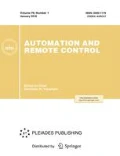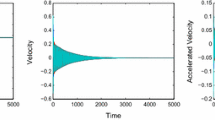Abstract
The paper studies the problem of achieving consensus in multi-agent systems in the case where the dependency digraph Γ has no spanning in-tree. We consider the regularization protocol that amounts to the addition of a dummy agent (hub) uniformly connected to the agents. The presence of such a hub guarantees the achievement of an asymptotic consensus. For the “evaporation” of the dummy agent, the strength of its influences on the other agents vanishes, which leads to the concept of latent consensus. We obtain a closed-form expression for the consensus when the connections of the hub are symmetric; in this case, the impact of the hub upon the consensus remains fixed. On the other hand, if the hub is essentially influenced by the agents, whereas its influence on them tends to zero, then the consensus is expressed by the scalar product of the vector of column means of the Laplacian eigenprojection of Γ and the initial state vector of the system. Another protocol, which assumes the presence of vanishingly weak uniform background links between the agents, leads to the same latent consensus.
Similar content being viewed by others
References
Olfati-Saber, R. and Murray, R.M., Consensus Problems in Networks of Agents with Switching Topology and Time-delays, IEEE Trans. Automat. Control, 2004, vol. 49, no. 9, pp. 1520–1533.
Mesbahi, M. and Egerstedt, M., Graph Theoretic Methods in Multiagent Networks, Princeton: Princeton Univ. Press, 2010.
Agaev, R.P. and Chebotarev, P.Yu., The ProjectionMethod for Reaching Consensus and the Regularized Power Limit of a Stochastic Matrix, Autom. Remote Control, 2011, vol. 72, no. 12, pp. 2458–2476.
Agaev, R.P. and Chebotarev, P.Yu., The Projection Method for Continuous-Time Consensus Seeking, Autom. Remote Control, 2015, vol. 76, no. 8, pp. 1436–1445.
Lin, Z., Low Gain Feedback, London: Springer, 1999.
Seo, J.H., Shim, H., and Back, J., Consensus of High-Order Linear Systems Using Dynamic Output Feedback Compensator: Low Gain Approach, Automatica, 2009, vol. 45, no. 11, pp. 2659–2664.
Su, H., Chen, M.Z., Lam, J., and Lin, Z., Semi-Global Leader-Following Consensus of Linear Multi- Agent Systems with Input Saturation via Low Gain Feedback, IEEE Trans. Circuits Syst. I: Regular Papers, 2013, vol. 60, no. 7, pp. 1881–1889.
Ren, W. and Cao, Y., Distributed Coordination of Multi-Agent Networks: Emergent Problems, Models, and Issues, London: Springer, 2011.
Chebotarev, P. and Agaev, R., Forest Matrices around the Laplacian Matrix, Linear Algebra Appl., 2002, vol. 356, pp. 253–274.
Chebotarev, P. and Agaev, R., The Forest Consensus Theorem, IEEE Trans. Automat. Control, 2014, vol. 59, no. 9, pp. 2475–2479.
Agaev, R.P. and Chebotarev, P.Yu., The Matrix of Maximum Out Forests of a Digraph and Its Applications, Autom. Remote Control, 2000, vol. 61, no. 9, pp. 1424–1450.
Chebotarev, P.Yu. and Shamis, E.V., The Matrix-Forest Theorem and Measuring Relations in Small Social Groups, Autom. Remote Control, 1997, vol. 58, no. 9, pp. 1505–1514.
DeGroot, M.H., Reaching a Consensus, J. Am. Stat. Ass., 1974, vol. 69, no. 345, pp. 118–121.
Brin, S. and Page, L., The Anatomy of a Large-Scale Hypertextual Web Search Engine, Comput. Networks ISDN Syst., 1998, vol. 30, pp. 107–117.
Langville, A.N. and Meyer, C.D., Google’s PageRank and Beyond: The Science of Search Engine Rankings, Princeton: Princeton Univ. Press, 2006.
Polyak, B.T. and Tremba, A.A., Regularization-Based Solution of the PageRank Problem for Large Matrices, Autom. Remote Control, 2012, vol. 73, no. 11, pp. 1877–1894.
Ishii, H. and Tempo, R., The PageRank Problem, Multiagent Consensus, and Web Aggregation: A Systems and Control Viewpoint, IEEE Control Syst. Mag., 2014, vol. 34, no. 3, pp. 34–53.
Agaev, R.P. and Chebotarev, P.Yu., Spanning Forests of a Digraph and Their Applications, Autom. Remote Control, 2001, vol. 62, no. 3, pp. 443–466.
Gantmacher, F.R., The Theory of Matrices, New York: Chelsea, 1959.
Meyer, C.D., Jr., The Role of the Group Generalized Inverse in the Theory of Finite Markov Chains, SIAM Rev., 1975, vol. 17, no. 3, pp. 443–464.
Rothblum, U.G., Computation of the Eigenprojection of a Nonnegative Matrix at Its Spectral Radius, in Stochastic Systems: Modeling, Identification and Optimization II, ser. Mathematical Programming Study, Wets, R.J.-B., Ed., Amsterdam: North-Holland, 1976, vol. 6, pp. 188–201.
Author information
Authors and Affiliations
Corresponding author
Additional information
Original Russian Text © R.P. Agaev, P.Yu. Chebotarev, 2017, published in Avtomatika i Telemekhanika, 2017, No. 1, pp. 106–120.
This paper was recommended for publication by O.N. Granichin, a member of the Editorial Board
Rights and permissions
About this article
Cite this article
Agaev, R.P., Chebotarev, P.Y. Models of latent consensus. Autom Remote Control 78, 88–99 (2017). https://doi.org/10.1134/S0005117917010076
Received:
Published:
Issue Date:
DOI: https://doi.org/10.1134/S0005117917010076




